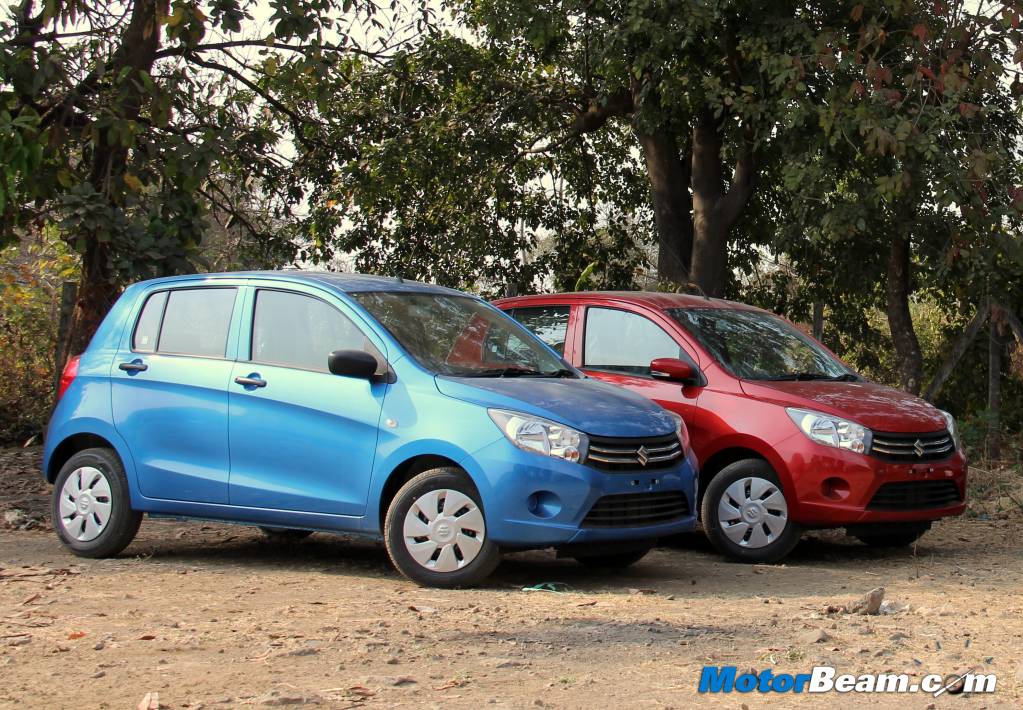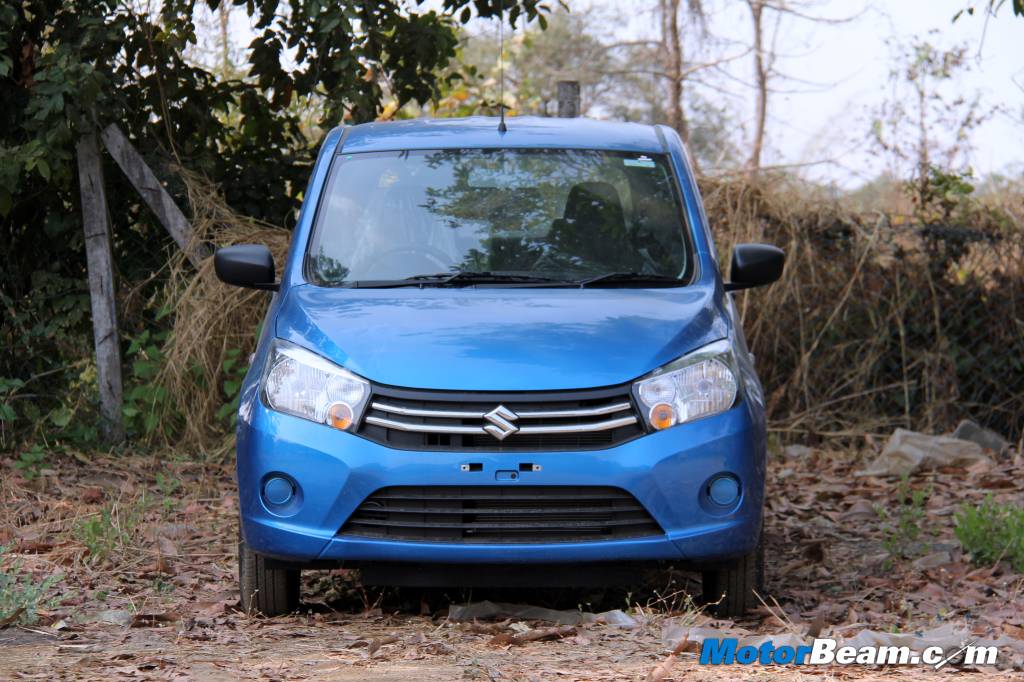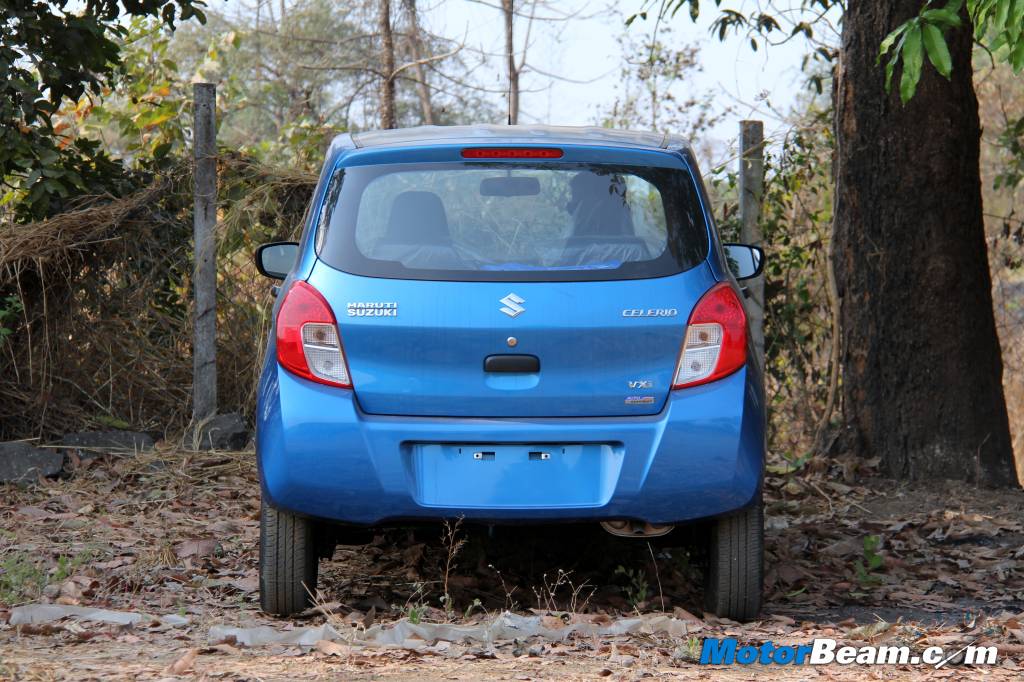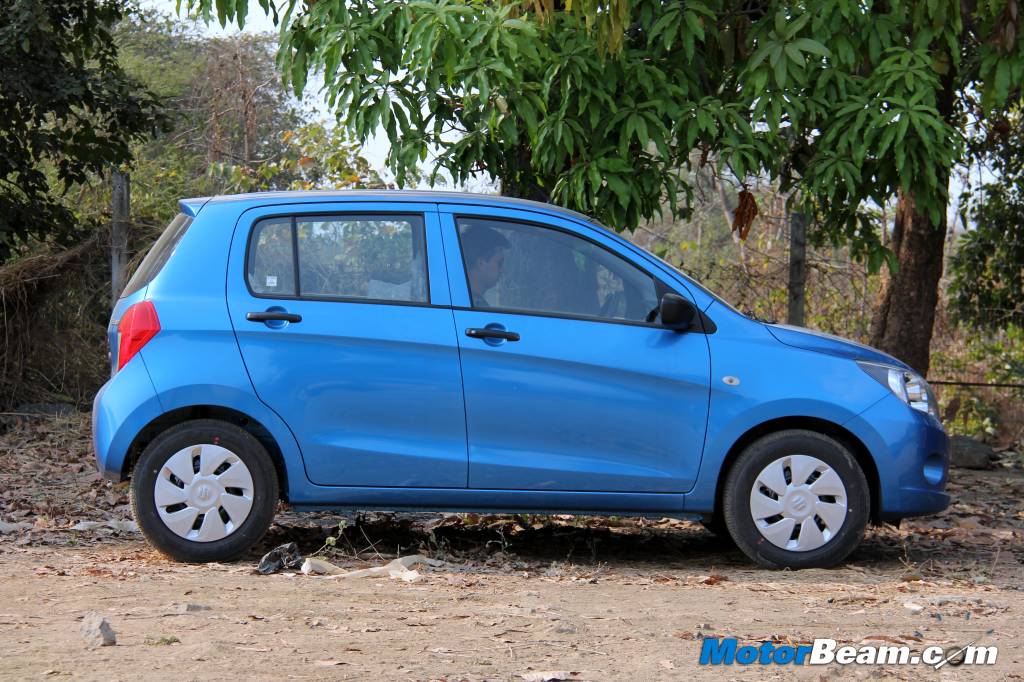
Maruti Suzuki Celerio Review
Car Tested: 2014 Maruti Suzuki Celerio
Price OTR Mumbai: Rs. 4.62 – 5.88 lakhs
The Maruti Celerio isn’t a game changer but undoubtedly better than the cars it replaces.
No matter how hard you try, somethings just aren’t heard, like in the case of automobiles how often have we heard India’s largest car manufacturer having a flop model in its portfolio. Rarely, but when Maruti Suzuki’s product does fail to sell, the company quickly makes amends by discontinuing the model and replacing it with something better. Such has been the case always and that’s why the Japanese automaker is replacing not one but two of its poorly performing cars in India with one product. The Zen Estilo and A-Star are being replaced by the Celerio, a car which also fills in the shoes of the Splash globally. Does the Maruti Celerio have what it takes to replace three cars? Suzuki thinks so, its ideology behind developing the Celerio was to make a vehicle which has the economy of the Alto (A-Star) and space of the Splash (Ritz). We put the Maruti Celerio through the thick and thin to see if this Maruti has what it takes to be a success.
Motor Quest: The Celerio name isn’t new as Suzuki has used the same nameplate for the Alto in certain markets for many years. However the latest Celerio will be sold worldwide with the same name.


The front resembles the Etios with a bit of Estilo in profile while the rear is very similar to the Alto 800
Exteriors – When was the last time you saw a well designed Maruti Suzuki car go into production, not easy to recall, right. This was long back when the Swift was first launched in 2005. The company has some excellent designers on board who put in all their energy in designing stellar concepts, just look at the R-III, XA Alpha, Authentics and iV-4. Heck, even look at the A:Wind which is the concept version of the Celerio and you would know what we mean. Somehow, the transition from concept to production messes many a things at Suzuki and that’s why the Celerio has ended up looking like a boring car. What happens when you take four cars and try to design a new vehicle taking inspiration from them. The result is the Maruti Celerio. The front looks very much like the Toyota Etios, the side profile has a bit of A-Star in it while the rear is almost like the Alto 800.

From certain angles, you will also notice the resemblance to the Zen Estilo. In fact when we went to drive the car, we saw it first from the rear and turned away thinking it’s the Alto 800, such is the resemblance. Even the A:Wind looked better although it has a similar shape. What has changed are the bumpers and lights which have totally robbed away the good appearance of the car. The LXi and VXi trim don’t get body coloured rear view mirrors and door handles while the ZXi also gets turn indicators on the rear view mirrors. This truly is a car which doesn’t look fresh at all and the styling really makes you believe it’s the replacement for the Alto 800 not A-Star.
Interiors – Maruti Suzuki has done a fabulous job with the interiors of the Celerio. Compared to the A-Star, there is a massive leap in terms of dashboard design and that’s solely because the company has lifted interior bits from its flagship hatchback. The gear lever and steering wheel come from the Swift but there are additional buttons for the Bluetooth telephony which are placed very unconventionally and seem like an after thought. The U-shaped centre console houses an integrated audio system with USB, AUX, CD, etc with manual AC controls. The dashboard has dual tone black and beige with neat contrasting silver inserts around the centre console and side AC vents.
There are decent storage spaces inside the cabin, the space below the AC vents is very much like the Swift with the same pattern of the ports. The gear lever is close to the dashboard like seen on the Ritz, this liberates space near the handbrake (there is a bottle holder behind it). There is an open storage box below the right most AC vent (ticket holder in marketing speak) and the doors have decent sized pockets too although the glovebox isn’t large enough to store much. Quality inside is sub par, both our test cars had things falling off and fit and finish really needs a re-visit. Panel gaps on a brand new car isn’t expected in today’s day and age, specially not from Maruti Suzuki. This comes as a shock considering the Celerio is a global model and such kind of quality will not be tolerated by international customers.
The Maruti Celerio has decent space inside the cabin and the company has managed to squeeze a lot of interior room. Space at the front was never a problem with the A-Star but the rear was very cramped, this has been resolved now. Tall people can sit at the rear although due to the narrow width of the car, the rear bench is best fit for two passengers. While rear legroom is decent and headroom is in abundance even for a six footer, under thigh support is just lacking. The car uses fixed headrests on all seats which hampers comfort at the rear although the front seats are quite comfortable but tend to vibrate a lot at low speeds due to the engine which lacks proper damping.
Maruti Suzuki has offered quite a lot of features in the Celerio including small bits like auto-locking doors, immobiliser, auto down driver side window, rear defogger, electrically adjustable rear view mirrors, etc. We are however baffled to see the Auto Gear Shift version is available only in LXi and VXi trim. The regular manual is offered in an additional ZXi and ZXi option variants. ABS, co-passenger airbag (driver side airbag is available in ZXi), alloy wheels, driver seat height adjustment and fog lamps are only offered in the option pack. So those who want the convenience of an automatic, don’t really deserve to be safe, that’s what Maruti feels. Not offering ZXi trim for the Auto Gear Shift model is simply not acceptable.
All variants of the Auto Gear Shift model get a tachometer and gear position indicator. The instrument cluster is very neat and has a large speedometer in the centre with a chrome outline. There is a LCD screen on the right which shows the fuel meter, odometer, trim meter, time, outside temperature, distance to empty, fuel consumption and low fuel warning lamp. The boot is decently sized at 235-litres (more boot space than the Swift) and the rear seats can be flipped forward in 60:40 split format which aids in practicality (not offered on the base LXi). The Celerio is a very light car (around 830 kgs) and that’s not really a good thing as the complete vehicle feels flimsy. Safety was certainly not a criteria when developing this car.
Performance – The Maruti Celerio uses the same engine which powered the cars it replaces. It is the same motor which propels the Wagon R but sees some changes. The 1.0-litre K10B motor (now called K-Next) gets drive-by-wire technology (instead of a mechanical linkage), reduced friction (thanks to redesigned valve springs), high pressure injectors and low viscosity engine oil. The changes aren’t a world apart but do end up improving the performance from the car which now produces the same 68 PS of power at 200 RPM earlier. Being a 3-cylinder unit, the Celerio’s engine has its achilles heel, the NVH is very poor which is amplified by the low weight of the car, resulting in everything from the gear lever to the pedals and seats vibrating at idle (noise isn’t much though but vibes are very intrusive). What the low weight does help in is, it gives the Maruti Celerio slick performance in the city, you do however have to keep the pedal depressed at low speeds to prevent stalling in crawling traffic, specifically in first gear.
The 3-pot unit is quick to respond to throttle inputs at low speeds and moves swiftly in stop and go conditions. However like most Suzuki petrol powertrains, rev the nuts of the motor and it makes an unpleasing whine, the Celerio goes one step ahead and sounds massively coarse near the 6100 RPM redline. The car debuts an improved 5-speed gearbox which although has slick shifts, can be a bit of an effort to use till you get used to the slight stiffness. The 1.2-litre K12 engine in the Ritz and Swift would have made a world of a difference to the Celerio but Maruti Suzuki is focussed on mileage, which the smaller petrol mill will deliver in abundance. Our VBOX runs with both manual and automatic versions of the Maruti Celerio revealed the 0-100 km/hr time to be 15.05 and 15.60 seconds respectively, which is decently quick for a car with such a pint sized motor.
The A-Star was offered with an automatic but Maruti Suzuki has opted for a cost effective solution with the Celerio, which uses an automated manual transmission, technology sourced from Magneti Marelli. This transmission is shared with the manual and doesn’t have a torque converter (thereby returns the same mileage as a manual), instead it uses an ECU to control gear shifts (using actuators), eliminating the need of a physical clutch. There is a creep mode which prevents clutch wear in slow moving conditions while a hold function prevents roll back on slopes. You have the option of leaving the box in auto mode while there is a manual mode as well (slot the lever to the left) wherein you can keep the gear engaged till redline to extract the most out of this mill. The EZ Drive does make driving very convenient but is very jerky and you can feel the clutch being activated most of the time. Since this is an automated manual gearbox, there is no P mode like in traditional automatics (there is M, D, N and R modes). The company claims a fuel efficiency of 23.1 km/l which is quite impressive.
Driving Dynamics – The biggest plus point about the Maruti Celerio is indeed how easy it is to drive. Piloting the car in congested traffic is effortless, more so if you are driving the model equipped with the automatic gear shift. Ride quality is very good, more so at low speeds as the suspension is on the softer side with the tyres running a high profile. Ride quality can get a bit messy at the rear as speeds build up, more so on really bad roads where the complete vehicle rattles a bit. Steering has no feel, while it’s light at low speeds, it simply doesn’t weigh up at high speeds. The EPS unit has little feedback to offer.
Small cars can be quite fun to throw around corners but the low grip tyres don’t help the Celerio’s cause. Yes the Celerio handles quite well and is very stable at speed but it somehow isn’t as agile as the Honda Brio, a car with which it will rub shoulders in India. Lack of ABS on the Auto Gear Shift model isn’t understandable at all, nor is ABS only being offered as part of an option on the ZXi trim digestible. This comes from a manufacturer who offers ABS as an option on mid-level variants of the Ritz and Swift while making it standard on all diesel trims of the Ertiga. Braking performance is decent but the pedal could offer better feel.
Verdict – The Maruti Celerio is an improved product, compared to the A-Star whose direct replacement it is. However it isn’t a vastly improved product which makes you question why the manufacturer did not go the long haul in taking a car which bombed so miserly, to the next level. The regular manual version of the Celerio doesn’t appeal much with the EZ Drive model being the only saving grace here. By using the intelligent and cost effective option, Maruti Suzuki will offer the cheapest automatic car in India in the Celerio. Although very jerky, the ease of driving offered by the Auto Gear Shift in the Celerio is sure to appeal to those on a budget. Being a Maruti Suzuki with a vast dealership network and aggressive pricing (for the lower trims), the Celerio is bound to be a success. However if you want a manual hatchback at this price point, there are better options.
The Maruti Celerio is a jack of some trades but master of none. Maruti continues to cut corners on several fronts and sadly safety is at the forefront of this exercise. The Celerio’s Auto Gear Shift is the only reason worth considering the vehicle.
What’s Cool
* City performance
* Easy to drive
* Cost effective auto gear shift
* Interior features
What’s Not So Cool
* Confused design
* Lack of safety features
* Engine vibrates, a lot
Alternatives: Honda Brio, Hyundai Grand i10
2014 Maruti Celerio Specifications
* Engine: 998cc, 3-cylinder, SOHC, K-Next
* Power: 68 HP @ 6000 RPM
* Torque: 90 Nm @ 3500 RPM
* Transmission: 5-Speed Manual, 5-Speed Auto Gear Shift
* Top Speed: 150 km/hr
* 0-100 km/hr: 15.05 seconds (manual), 15.6 seconds (Auto Gear Shift)
* Fuel Consumption: 15 km/l (City), 18 km/l (Highway)
* Fuel Type: Petrol
* Suspension: McPherson Struts (Front), Torsion Beam (Rear)
* Tyres: 155/80/13 (LXi), 165/70/14 (VXi, ZXi)
* Brakes: Ventilated Disc (Front), Drum (Rear)
* Safety: Immobiliser, Driver side airbag, optional ABS and passenger side airbag
2014 Maruti Celerio Dimensions
* Overall length x width x height: 3600 mm X 1600 mm X 1560 mm
* Wheelbase: 2425 mm
* Turning Radius: 4.7 metres
* Ground clearance: 165 mm
* Boot Volume: 235 liters
* Fuel Tank Capacity: 35 litres
* Kerb Weight: 830 kgs
Further Reading –
Maruti Suzuki Celerio vs Hyundai Grand i10




